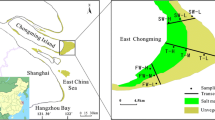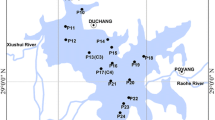Abstract
Temperature is an important factor that affects nitrogen (N) transformations in an aquatic ecosystem. In this study, the surface sediments (0 to − 2 cm) from both outer and inner Meiliang Bay (OMB; IMB) were collected. A laboratory incubation experiment was conducted at different temperatures (10 °C, 20 °C and 30 °C) by the 15N tracing technique. Gross N transformation rates, including nitrification and denitrification, and NH4+ (ia) and NO3− (in) immobilization rates were estimated by the FLUAZ model. The results showed that both nitrification and denitrification rates of sediments were significantly higher in IMB than in OMB at any temperature (p < 0.05). The ia reached the highest value and was of significant difference between the bays at 20 °C (p < 0.05) with in less than 0.4 mg kg−1 dry weight sediment (d.w.s.) per day. Increasing temperature caused increased gross N transformation rates in each bay, and the temperature significantly affected nitrification, denitrification and ia rates (p < 0.05). The N transformation rates differed among different sampling sites, mainly due to their significantly different total organic carbon values (p < 0.05). In both bay sediments, microbial immobilization assimilated more NH4+ at 20 °C. The consumption of NH4+ was more by nitrification (55–77%) than by immobilization in the surface sediments of the IMB; likewise 38–73% of NH4+ was consumed by nitrification in the OMB. These findings suggested that temperature dramatically affected the N transformations in surface sediments of Taihu Lake, and the destination of inorganic N varied with temperature.






Similar content being viewed by others
References
Abell GCJ, Banks J, Ross DJ, Keane JP, Robert SS, Revill AT, Volkman JK (2011) Effects of estuarine sediment hypoxia on nitrogen fluxes and ammonia oxidizer gene transcription. FEMS Microbiol Ecol 75:111–122
Caffrey JM (1993) Effect of organic loading on nitrification and denitrification in a marine sediment microcosm. FEMS Microb Ecol 12(3):159–167
Chai B, Huang T, Zhao X (2016) Microbial effects on nitrogen circulation and transformation on water-sediment interface of source water reservoir. J Environ Sci 51:109–114
Chen XF, Chuai XM, Zeng J, Liu T, Yang LY (2012) Nitrogenous fluxes and its self-purification capacity in lake Taihu. Environ Sci 33(7):2309–2314
Chen ZZ, Zhang JB, Xiong ZQ, Pan G, Müller C (2016) Enhanced gross nitrogen transformation rates and nitrogen supply in paddy field under elevated atmospheric carbon dioxide and temperature. Soil Biol Biochem 94:80–87
Dan XQ, Chen ZX, Dai SY, He XX, Cai ZC, Zhang JB, Müller C (2019) Effects of Changing Temperature on Gross N Transformation Rates in Acidic Subtropical Forest Soils. Forests 10(10):894
Dessureault-Rompre J, Zebarth BJ, Georgallas A, Burton DL, Grant CA, Drury CF (2010) Temperature dependence of soil nitrogen mineralization rate: comparison of mathematical models, reference temperatures and origin of the soils. Geoderma 157:97–108
Duan SW, Kaushal SS (2013) Warming increases carbon and nutrient fluxes from sediments in streams across land use. Biogeosciences 10:1193–1207
EPA (1993) Nitrogen control manual. United States Environmental Protection Agency, Washington, pp 101–105
Fang C, Smith P, Smith JU (2005) Is resistant soil organic matter more sensitive to temperature than the liable organic matter? Biogeosciences 2:725–735
Fernandes SO, Javanaud C, Michotey VD, Guasco S, Anschutz P, Bonin P (2016) Coupling of bacterial nitrification with denitrification and anammox supports N removal in intertidal sediments (Arcachon Bay, France). Estuar Coast Shelf Sci 179:39–50
Galloway JN, Townsend AR, Erisman JW, Bekunda M, Cai Z, Freney JR, Martinelli LA, Seitzinger SP, Sutton MA (2008) Transformation of the nitrogen cycle: recent trends, questions, and potential solutions. Science 320(5878):889–892
Gier J, Sommer S, Löscher CR, Dale AW, Schmitz RA, Treude T (2016) Nitrogen fixation in sediments along a depth transect through the Peruvian oxygen minimum zone. Biogeosciences 13(14):4065–4080
Hoyle FC, Murphy DV, Fillery IRP (2006) Temperature and stubble management influence microbial CO2–C evolution and gross N transformation rates. Soil Biol Biochem 38:71–80
Hoyle FC, O’Leary RA, Murphy DV (2016) Spatially governed climate factors dominate management in determining the quantity and distribution of soil organic carbon in dryland agricultural systems. Sci Rep 6:31468
Huang TL, Xu JL, Cai DJ (2011) Efficiency of active barriers attaching biofilm as sediment capping to eliminate the internal nitrogen in eutrophic lake and canal. J Environ Sci 23(5):738–743
James RT, Havens K, Zhu GW, Qin BQ (2009) Comparative analysis of nutrients, chlorophyll and transparency in two large shallow lakes (Lake Taihu, PR China and Lake Okeechobee, USA). Hydrobiologia 627:211–231
Kim JH, Guo X, Park HS (2008) Comparison study of the effects of temperature and free ammonia concentration on nitrification and nitrite accumulation. Process Biochem 43:154–160
Kirschbaum MUF (1995) The temperature dependence of soil organic matter decomposition, and the effect of global warming on soil organic C storage. Soil Biol Biochem 27:753–760
Lan T, Han Y, Roelcke M, Nieder R, Cai ZC (2014) Sources of nitrous and nitric oxides in paddy soils: nitrification and denitrification. J Environ Sci 26(3):581–592
Larsen KS, Andresen LC, Beier C, Jonasson S (2011) Reduced N cycling in response to elevated CO2, warming, and drought in a Danish heathland: synthesizing results of the CLIMAITE project after two years of treatments. Glob Change Biol 17:1884–1899
Liu HQ, Fang Z, Meng Y, Yuan ZJ (2020) Water quality assessment around Lake Taihu. Ecol Environ Sci 29(11):2262–2269
Mary B, Recous S, Robin D (1998) A model for calculating nitrogen fluxes in soil using 15N tracing. Soil Biol Biochem 30(14):1963–1979
Miranda J, Balachandran KK, Ramesh R, Warfar M (2008) Nitrification in Kochi backwaters. Estuar Coast Shelf Sci 78:291–300
Nannipieri P, Paul E (2009) Chemical and functional characterization of soil N and its biotic components. Soil Biol Biochem 42(5):863
Richardson JM, Makhatadze GI (2004) Temperature dependence of the thermodynamics of helix–coil transition. J Mol Biol 335(4):1029–1037
Rivera-Monroy VH, Twilley RR (1996) The relative role of denitrification and immobilization in the fate of inorganic nitrogen in mangrove sediments (Terminos Lagoon, Mexico). Limnol Oceanogr 41(2):284–296
Rivera-Monroy VH, Twilley RR, Boustany RG, Day JW, Vera-Herrera F, del Carmen Ramirez M (1995) Direct denitrification in mangrove sediments in Terminos Lagoon, Mexico. Mar Ecol Prog Ser 126:97–109
Silvennoinen H, Liikanen A, Torssonen J, Stange CF, Martikainen PJ (2008) Denitrification and nitrous oxide effluxes in boreal, eutrophic river sediments under increasing nitrate load: a laboratory microcosm study. Biogeochemistry 91(2–3):105–116
Stottlemyer R, Toczydlowski D (1999) Nitrogen mineralization in a mature boreal forest, Isle Royale, Michigan. J Environ Qual 28:709–720
Strauss EA, Lamberti GA (2000) Regulation of nitrification in aquatic sediments by organic carbon. Limnol Oceanogr 45:1854–1859
Strauss EA, Mitchell NL, Lamberti GA (2002) Factors regulating nitrification in aquatic sediments: effects of organic carbon, nitrogen availability, and pH. Can J Fish Aquat Sci 59:554–563
Tourna M, Stieglmeier M, Spang A, Könneke M, Schintlmeister A, Urich T, Engel M, Schloter M, Wagner M, Richter A, Schleper C (2011) Nitrososphaera viennensis, an ammonia oxidizing archaeon from soil. Proc Natl Acad Sci USA 108:8420–8425
von Lützow M, Kögel-knabner I (2009) Temperature sensitivity of soil organic matter decomposition—What do we know? Biol Fertil Soils 46(1):1–16
Wallenstein M, Hall EA (2012) A trait-based framework for predicting when and where microbial adaptation to climate change will affect ecosystem functioning. Biogeochemistry 109(1–3):35–47
Wang Y, Wang D, Wu J (2015) Assessing the impact of Danjiangkou reservoir on ecohydrological conditions in Hanjiang river, China. Ecol Eng 81:41–52
Wang J, Zhang JB, Müller C, Cai ZC (2016) Temperature sensitivity of gross N transformation rates in an alpine meadow on the Qinghai-Tibetan Plateau. J Soils Sediment 17:423–431
Wu YC, Ke XB, Hernández M, Wang BZ, Dumont MG, Jia ZJ, Conrad R (2013) Autotrophic growth of bacterial and archaeal ammonia oxidizers in freshwater sediment microcosms incubated at different temperatures. Appl Environ Microbiol 79:3076–3084
Xue W, Lu SY (2015) Effects of inactivation agents and temperature on phosphorus release from sediment in Dianchi Lake, China. Environ Earth Sci 74:3857–3865
Zeng J, Zhao DY, Yu ZB, Huang R, Wu QLL (2014) Temperature responses of ammonia-oxidizing prokaryotes in freshwater sediment microcosms. PLoS ONE 9(6):100653
Zhang PY, Wen T, Zhang JB, Cai ZC (2017) On Improving the diffusion method for determination of δ15N-NH4+ and δ15N-NO3− in soil extracts. Acta Pedol Sin 54(4):948–957
Zhong JC, Fan CX, Liu GF, Zhang L, Shang JG, Gu XZ (2010) Seasonal variation of potential denitrification rates of surface sediment from Meiliang Bay, Taihu Lake, China Seasonal variation of potential denitrification rates of surface sediment from Meiliang Bay, Taihu Lake, China. J Environ Sci 22(7):961–967
Zhou S, Sakiyama Y, Riya S, Song XF, Terada A, Hosomi M (2012) Assessing nitrification and denitrification in a paddy soil with different water dynamics and applied liquid cattle waste using the 15N isotopic technique. Sci Total Environ 430(8):93–100
Zhou XP, Chen NW, Yan ZH, Duan SW (2016) Warming increases nutrient mobilization and gaseous nitrogen removal from sediments across cascade reservoirs. Environ Pollut 219:490–500
Acknowledgements
This work was supported by the National Natural Science Foundation of China [Grant Numbers 41730753, 42077033 and 42277287], Jiangsu Cyanine Engineering Project (2021) and Changzhou Vocational Institute of Engineering Doctoral Scientific Research Fund (2021).
Author information
Authors and Affiliations
Corresponding author
Supplementary Information
Below is the link to the electronic supplementary material.
Rights and permissions
Springer Nature or its licensor (e.g. a society or other partner) holds exclusive rights to this article under a publishing agreement with the author(s) or other rightsholder(s); author self-archiving of the accepted manuscript version of this article is solely governed by the terms of such publishing agreement and applicable law.
About this article
Cite this article
Wu, L., Zhong, W., Qin, H. et al. Significance of temperature control in nitrogen transformations in surface sediments of Taihu Lake, China. Paddy Water Environ 21, 193–203 (2023). https://doi.org/10.1007/s10333-022-00921-7
Received:
Revised:
Accepted:
Published:
Issue Date:
DOI: https://doi.org/10.1007/s10333-022-00921-7




